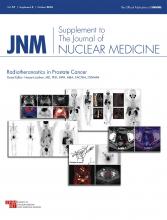Article Figures & Data
Tables
- TABLE 1
Clinical Scenarios with Areas of Need That Should Be Addressed with Molecular Imaging
Clinical scenario Specific clinical questions References Screening Screening and stratification in patients with no diagnosis of cancer Identify significant vs. nonsignificant cancer (1–7) Determine predictive value of index and nonindex lesions within intact prostate (8–21) Therapy for localized prostate cancer Planning therapy for clinically localized cancer Perform staging to determine whether metastatic disease is present (22–26) Locate disease within pelvic lymph nodes that can be incorporated into radiotherapy field or planned lymph node dissection (27–35) Evaluating after definitive local therapy Adjuvant therapy Identify early micrometastatic disease that would eliminate need for radiotherapy (22,36–43) PSA elevation after local therapy Reliably delineate recurrence in patients in whom nadir or PSA rise is lacking after radiotherapy or radical prostatectomy (43–60) Distinguish between M0 hormone-naïve prostate cancer and M0 castration-resistant prostate cancer (61–63) Salvage radiotherapy Identify sites of recurrent disease that can or cannot be targeted by radiation (either in prostate bed or elsewhere) (64–70) Metastatic disease Oligometastatic prostate cancer Identify sites of oligometastases to determine whether stereotactic body radiotherapy or resection is appropriate (40,70–76) Diffuse metastatic disease Obtain reliable information on bone metastases for palliative radiotherapy targeting (67,77–80) Delineation of metastatic distribution Determine low- and high-risk patients for selection of systemic therapy (41,73,78,81,82) Early imaging response Predict response to therapy or duration of survival (42,63,83–91)







